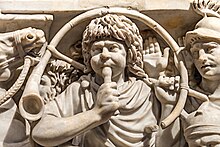Cornicen


The cornicen (plural cornicines ) was a horn blower in the Roman army and part of the military musicians ( aeneatores ).
In early Rome, the Cornicines called those who were capable of arms to the Centuriatskomitien and were already employed in the militia army at that time. In the time of the republic , when changing from the phalanx to manipulartactics , the cornicen was used in the troop body of the first centuria of a manipel. During the imperial era , when the cohort of a legion had developed as the primary tactical combat unit, the hornblower retained its place in the still existing maniple. It was also marked here, presumably with a predator's skin.
Function of the cornicines
The hornblower's place in battle was in the immediate vicinity of the field sign bearer ( signifer ). The cornicen was used as a tactical command and control tool for the acoustic transmission of commands from the centurio or its deputy optio , in particular to the optically forwarding command transmitter, the standard bearer, when combat formations were to be taken to attack, collect or retreat. In addition, the roar of the horns should amplify the loud sound of the tubes and, combined with the battle cry of the attacking army, demoralize the enemy. As reported Flavius Josephus in his treatise on the Jewish War that he ordered his fighters to stop up their ears to the intimidating sounds of war to escape the Romans. But there were cornicines in the Roman fleet as well . In marching formations to or outside of a battle, but also to the parade , the unit was accompanied by the game of the cornicines . With their signal they also called the night guards from their posts. In ceremonial acts, such as the cult acts of the Tubilustrium and Suovetaurilia , which served the ritual cleansing ( lustratio ) of the army, the cornu was played in addition to the tubus . During the rites of the Tubilustrium, the wind players were obliged to clean their instruments.
Still below the rank of non-commissioned officer ( principales ), the cornicen was probably counted among the higher ranks ( immune ), but ranked behind the tubicines . He belonged to the special functionaries of the Roman army, who were freed from the everyday service devices ( munera militae ) of the simple legionaries. The cornicines otherwise had no authority and received the same pay as the other crew members ( legionarius ).
Cornu
The cornu was of Etruscan origin and was a circularly curved horn made of bronze, weighing around 4 kg, which was used as a wind instrument and, due to its size , had to be carried with both hands by the cornicen . The hornblower was therefore unable to carry the large shield ( scutum ) of a legionnaire and was therefore originally unarmed. For his protection, in a possible close combat, he wore the smaller round shield ( parma equestris ) of a Roman rider on his back as a protective weapon from the imperial era .
literature
- Otto Fiebiger : Cornicines. In: Paulys Realencyclopadie der classischen Antiquity Science (RE). Volume IV, 1, Stuttgart 1900, Col. 1602 f.
- Alfred Neumann : Cornicines. In: The Little Pauly (KlP). Volume 1, Stuttgart 1964, column 1320.
- Marcus Junkelmann : The Legions of Augustus . Zabern, Mainz 6th edition 1994, pp. 94, 109-110, 214-218.
Remarks
- ↑ Aulus Gellius , noctes Atticae 15, 27.
- ^ Titus Livius , ab urbe condita 1, 43, 7 ( German translation ).
- ^ Alfred Neumann : Manipulus. In: The Little Pauly (KlP). Volume 3, Stuttgart 1969, column 960.
- ^ Vegetius , epitoma rei militari 2, 22.
- ↑ Flavius Josephus, Vom Jewish Kriege Buch 3, 259–266 (25–27).
- ↑ CIL 10, 03416
- ^ Vegetius, epitoma rei militari 3, 8.
- ^ Yann Le Bohec : The Roman Army , Nikol, Hamburg 2009, ISBN 978-3-86820-022-5 , p. 54.
- ^ Vegetius, epitoma rei militari 2, 7.
